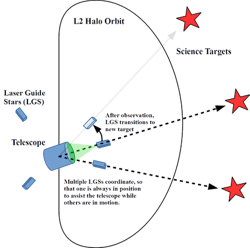
A new twist on the laser guide star could help future large space telescopes study extrasolar planets. The idea is to focus a laser beam from a separate small spacecraft onto the telescope so that its control system can keep its mirror aimed precisely at a faint Earthlike exoplanet, compensating for any tiny vibrations that could blur the images. Scientists at the Massachusetts Institute of technology (MIT; Cambridge, MA) say such a space-based laser guide star is within the reach of current technology.
Terrestrial laser guide stars help adaptive optics on large ground-based telescopes compensate for air fluctuations that make stars twinkle. Typically, a ground-based laser emitting at 589 nm is aimed upward to illuminate a layer of sodium atoms about 90 km above the ground. The sodium atoms absorb the beam, then re-emit light at the same wavelength, producing a star-like point of yellow light high in the atmosphere. Sensors on the telescope measure the wavefront of the returned yellow light, and the adaptive optics system uses that information to adjust the shape of a flexible mirror to offset the effects of atmospheric perturbations between the telescope and the guide star. That has given large ground-based telescopes unprecedented resolution of astronomical objects that had once been just blurs from the ground.Air currents do not affect large space-based telescopes, but tiny vibrations within the instruments themselves can limit their seeing. Solar heating and cooling of solar panels caused troublesome vibrations of the Hubble Space Telescope after its 1990 launch, but replacing the original panels stabilized Hubble so that it could produce its famed crystal-sharp images. The big concern for future large space telescopes such as the James Webb Space Telescope comes from their use of segmented mirrors that are folded for launch, then unfolded when they reach space. Earthlike exoplanets are up to 10 billion times fainter than the stars they orbit, so tiny vibrations of telescope components could scatter enough light from the star to obscure terrestrial exoplanets orbiting in the star’s habitable zone.
To develop a space-based laser guide star for large space telescopes, Kerri Cahoy and Ewan Douglas of the MIT Aeronautics and Astronautics department set out to adapt technology developed for small laser communications spacecraft. Such a guide star would be stationed between the telescope and the exoplanet system being observed, pointing a laser beam toward the telescope. The low-power beam would look like a star in the field being observed, so adaptive optics in the telescope could monitor laser light reflected from the segmented mirror to detect vibrations that could scatter starlight. This could both improve performance of future exoplanet missions and ease demanding engineering requirements that drive up telescope costs.
"We know how to build laser transmitters for communications that can point very well from satellite to satellite over 30,000 kilometers, so why not do something like that with a telescope," Cahoy says. Their cubesat communication satellites use radio links for initial alignment and MEMS tilting mirrors for beam steering, and eventually create a feedback loop that locks the beam path between the satellites tens of thousands of kilometers apart. Similar equipment can align the laser guide stars with the space telescope.
Webb was not designed for high-contrast exoplanet imaging, says Douglas, so they are developing their design for the Large UV Optical Infrared Surveyor (LUVOIRS), a NASA plan for a future 8 to 18 m telescope to search for habitable exoplanets. That telescope will include an internal coronagraph to block starlight while searching for faint planets in habitable orbits around the star.
Like Webb, LUVOIRS will orbit at the Lagrange 2 (L2) point, which is beyond the Moon and about 1.5 million km from Earth. In the Astronomical Journal, Douglas, Cahoy, and colleagues envision guide stars 43,000 or 80,000 km from the telescope, with a laser beam divergence of 3.861 or 12.49 arcsec. Powers of tens to hundreds of milliwatts should suffice at laser wavelengths around 976 nm, Cahoy says. She also says that their guide star would improve seeing enough for the telescope to quadruple the number of star systems it could search for exoplanets.
In practice, a single cubesat would not suffice, because the laser guide star must be stationed precisely between the telescope and the observing field, says team member Jim Clark. Cubesats use electric propulsion, which is efficient but slow, so it would take a long time to move single one between observing fields. Clark says use of telescope time could be optimized by stationing 8–12 laser guide stars around it, arranged to minimize the time lost moving the telescope between the stars.
So far, the group has concentrated on models, but the researchers are now developing a laboratory-scale testbed.
About the Author
Jeff Hecht
Contributing Editor
Jeff Hecht is a regular contributing editor to Laser Focus World and has been covering the laser industry for 35 years. A prolific book author, Jeff's published works include “Understanding Fiber Optics,” “Understanding Lasers,” “The Laser Guidebook,” and “Beam Weapons: The Next Arms Race.” He also has written books on the histories of lasers and fiber optics, including “City of Light: The Story of Fiber Optics,” and “Beam: The Race to Make the Laser.” Find out more at jeffhecht.com.

